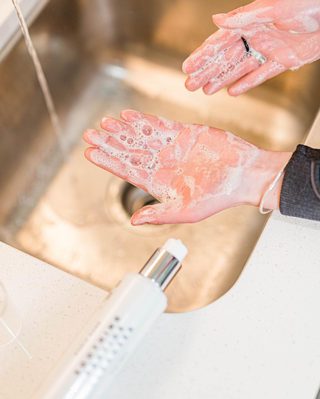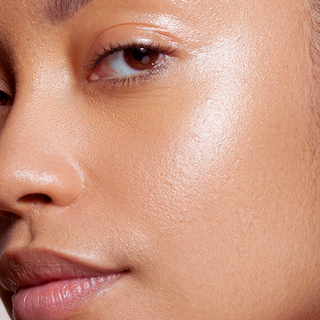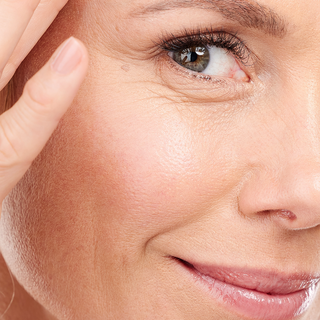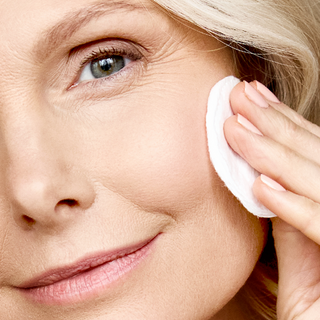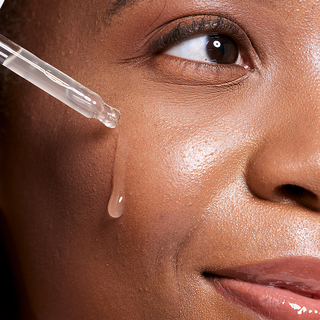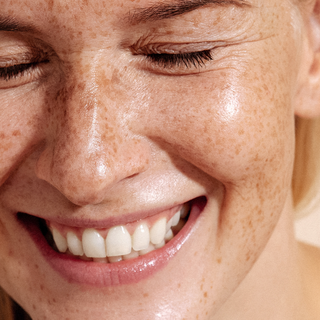If cleansing leaves your skin feeling tight or like there’s a film, chances are your cleanser isn’t doing you any favors.
The cleanser you choose can make or break your skincare results.
As someone who believes in results without irritation, I’m here to break down the two most misunderstood categories: foaming vs hydrating cleansers. You don’t need a 12-step routine, just the right cleanser, applied at the right time.
Let’s simplify your routine and get your skin back to glowing.
What Does A Cleanser Actually Do?
Your cleanser sets the tone for everything else in your routine.
If you’re layering beautiful serums and moisturizers on top of skin that wasn’t properly cleansed, you’re wasting product, and likely irritating your skin in the process.
A great cleanser doesn’t just remove makeup or sunscreen, it lifts away excess oil, pollution, and the invisible buildup that clogs pores and dulls your glow. Think of it as your reset button.
Whether it’s the end of a long day or the beginning of a new one, cleansing creates the clean canvas your skin needs to truly benefit from the treatments that follow, like your favorite retinol, vitamin C serum, or SPF.
But here’s the catch: not all cleansers are created equal.
Texture matters. pH matters. Ingredients matter. One of the biggest myths I hear? That suds equal clean. That a foaming, bubbly lather is proof that your cleanser is “working.” Honestly, that couldn’t be further from the truth.
Yes, foaming cleansers feel satisfying. But for many people, especially those with dry, sensitive, or barrier-compromised skin, that rich lather can come at a cost.
If your skin feels “squeaky clean” or tight afterward, it’s a red flag. That’s not cleanliness, it’s stripping, and it means your skin’s protective barrier has been disrupted.
Over time, that can lead to more breakouts, dehydration, and irritation.
My philosophy? Your cleanser should never leave your skin feeling raw or reactive. It should cleanse, yes, but gently. It should support the health of your skin barrier, not wage war on it.
This is why I built my skincare line with purposeful cleansers, ones that prep the skin, not punish it.
The Cleanser Lowdown: Which Formula Fits Your Skin Best?
Cleansers come in all forms, oils, gels, balms, bars, but in my world, the two that make the biggest difference for most people are foaming and hydrating cleansers.
And trust me, knowing which one to use (and when) can be a game-changer for your skin.
Foaming Cleansers
If you’ve got oily, combination, or acne-prone skin, foaming cleansers probably feel like a breath of fresh air. They create that light, sudsy lather we often associate with “clean.”
These formulas are great for cutting through oil, sweat, and pollution, especially after a workout or on a hot summer day when your skin feels like it’s suffocating under sunscreen and humidity.
These cleansers can work beautifully when used correctly and on the right skin type, but they also tend to overdo it when used too frequently or by someone with dry or sensitive skin. If you’re feeling stripped, tight, or red afterward, it’s your skin telling you it’s had enough.
That’s why I created the Essential Lactic Acid Cleanser, a balanced foaming formula that gently exfoliates dull skin without bulldozing your barrier. It’s ideal for normal, oily, or combination skin types that need a reset without the harsh rebound. Lactic acid is hydrating, while also exfoliating, making it ideal for combination skin.
Hydrating Cleansers
Now, if your skin leans on being dry, sensitive, or compromised in any way, especially if you’re using actives like retinol or just got back from a long day in the sun, hydrating cleansers are your holy grail.
These are typically cream-based, non-foaming, and built to nourish while they cleanse.
My Soothing Peptide Cleanser was designed with exactly this in mind.
It’s sulfate-free, deeply calming, and effective enough to remove makeup without the sting. Soothing Peptide Cleanser features panthenol, which preps the skin like a wet sponge to absorb all the active ingredients in your serums and moisturizer. It’s also my go-to recommendation for anyone post-procedure, dealing with irritation, or layering exfoliants and retinoids. It cleans without disrupting the very thing we’re trying to heal.
Foaming Cleanser VS Hydrating Cleanser: Here’s How To Decide
There’s no such thing as a “one-size-fits-all” cleanser.
I’ve seen so many people frustrated by using the wrong cleanser at the wrong time.
And when you make the right swap? Everything changes, hydration improves, breakouts ease, and suddenly the rest of your skincare works better.
Here’s a quick breakdown to help you decide:
|
Feature |
Foaming Cleanser |
Hydrating Cleanser |
|
Best For |
Oily, combo, acne-prone skin |
Dry, sensitive, barrier-compromised skin |
|
Texture |
Gel or cream-to-foam |
Creamy, balm-like |
|
Use Case |
Makeup removal, PM cleanse |
Morning routine, hydration boost |
|
Key Ingredients |
Salicylic acid, lactic acid |
Ceramides, peptides, hyaluronic acid |
Now, let’s go a layer deeper: yes, skin type absolutely matters.
-
If you’re oily or acne-prone, a foaming cleanser can help remove excess sebum and unclog pores.
-
If you’re dry, sensitive, or going through a retinol transition phase, a hydrating formula is going to feel like a warm hug.
But skin is dynamic, not static. And yes, time of day matters too.
I personally love a hydrating cleanse in the morning to retain moisture and prep for the day. Then at night, after SPF, makeup, and the stress of life? I reach for a foaming cleanser to really sweep everything away.
Still can’t choose? Use both.
Seriously. Double cleansing is one of the smartest (and most misunderstood) tools in your skincare arsenal. Start with a hydrating cleanser to nourish and loosen surface debris, then follow with a foaming cleanser for a deeper clean, especially if you wear makeup or live in a humid climate.
My go-to for this is the Clarifying Salicylic Cleanser. It’s a foaming formula that uses salicylic acid to cut through congestion without leaving your skin raw.
I recommend it for evening use, particularly for those with oily or breakout-prone skin who want results without irritation.
At the end of the day, it’s about listening to your skin, matching your cleanser to your needs, and understanding that the right formula can change everything.
Are You Overcleansing? (And Why That Tight Feeling Isn’t A Sign Of ‘clean’)
That tight, almost rubbery sensation of “squeaky clean” might feel satisfying in the moment, but what you’re actually feeling is your moisture barrier waving a white flag.
And once that barrier is compromised, things can spiral fast: irritation, breakouts, dullness, and chronic dehydration.
Foaming cleansers with harsh surfactants often go too far, removing not just dirt and oil, but the healthy lipids your skin needs. When your barrier is compromised, everything stings, flakes, or stops working.
On the other hand, hydrating cleansers might not foam, but that doesn’t mean they’re ineffective. In fact, they’re often better at protecting and supporting your skin, especially if you’re using retinol or exfoliants. That dewy “film” they leave behind? It’s not residue, it’s hydration, exactly where you need it.
If you’re not sure which camp your skin falls into, it’s time to patch-test and observe.
Try using a new cleanser once a day for a week (ideally at night when your skin is more exposed to buildup) and pay attention:
-
Are you getting drier?
-
Breaking out?
-
Feeling soothed?
-
Do you need to moisturize immediately, or does your skin feel naturally calm?
And don’t underestimate the power of timing. Your skin’s need change throughout the year – foaming cleanser that feels great in August may be too harsh in January.
If you’re hitting a dry patch mid-retinol cycle or noticing more flakiness than usual, it’s a clear sign to switch to something barrier-supportive like my Soothing Peptide Cleanser.
Your skin isn’t asking for more steps. It’s asking for the right ones. Cleanse smart. Your glow depends on it.
How To Choose The Right Cleanser For You
Here’s the secret: your skin will tell you exactly what it needs, if you know how to listen.
Too often, people get caught up in trendy product recommendations without asking the most important questions about how their skin actually behaves.
Start here:
-
Does your skin feel tight, shiny, or flaky after cleansing? Tightness = overcleansing. Shine might indicate excess oil. Flakiness? You’re likely dehydrated or your barrier’s been disrupted.
-
Do you wear heavy SPF or full makeup most days? If so, you need a cleanser that actually breaks that down, especially at night.
-
Are you using retinoids or exfoliating acids? Then you’re already asking a lot of your skin. Your cleanser should support, not compete with, your actives.
-
Does your skin behave differently in the summer vs. winter? That’s normal, and it’s your cue to rotate products just like you do your wardrobe.
So which formula fits your real-life skin?
Your Cleanser Cheat Sheet:
🔹 Oily Or Breakout-Prone?
Start with the Clarifying Salicylic Cleanser or the Essential Lactic Acid Cleanser. Both offer gentle exfoliation to unclog pores and manage shine, without the stripping effect that sets your skin back.
🔹 Dry Or Reactive?
The Soothing Peptide Cleanser is your best friend. It calms and cleans without compromising your barrier, especially critical if you’re on actives, post-treatment, or just naturally sensitive.
🔹 Combination Skin?
Rotate based on your needs.
Use a foaming cleanser when your T-zone gets oily (usually in warmer months), and a hydrating cleanser when your cheeks feel tight or flaky.
Or try double cleansing: hydrating first to cushion and dissolve buildup, foaming second to finish the job without overdoing it.
I designed these formulas with real clients in mind, men and women who don’t have time for guesswork but want real results.
Trust me: when your cleanser fits your lifestyle and skin type, everything else falls into place.
Confused About Cleansers? Here’s What Most People Get Wrong
Nobody just really wants “clean” skin. What people actually want is comfort, glow, and simplicity that works.
Over the years, I’ve seen so many people feel overwhelmed by their skincare routines: skin stripped, irritated, or just not responding the way they hoped.
And more often than not, it all traces back to one thing: using the wrong cleanser, or not fully understanding what that cleanser is doing to their skin. These are the kinds of questions I hear all the time:
“Can Hydrating Cleansers Work In Summer?”
Absolutely. Just because it’s hot doesn’t mean your skin stops needing hydration. If your skin leans dry or you’re using retinol or other actives, a hydrating cleanser can still be your best defense, even in humid weather.
Think of it like drinking water in the heat, non-negotiable.
Why Does My Cleanser Leave A Residue?
What you’re feeling might not be “residue” but a protective finish, especially if you’re using a nourishing, non-stripping formula.
The goal isn’t to scrub your face into squeaky submission. It’s to gently remove what doesn’t belong and leave behind what does: balance, moisture, and calm.
Which One Removes Makeup Better?
Here’s where function matters. If you’re wearing heavier makeup or SPF, I recommend starting with a hydrating cleanser like my Soothing Peptide Cleanser, which melts away product without burning your eyes or drying your skin.
For oilier skin or a second cleanse, follow up with a foaming option like the Clarifying Salicylic Cleanser. That combo delivers both nourishment and a clean slate.
The takeaway? Stop trying to fit your skin into a box. Your cleanser should reflect how you live, what you’re using on your skin, and how your skin feels today.
Cleanse Smarter With Maria Kane
When I created the Maria Kane cleanser line, it was based on real skin, real concerns, and real conversations. I’ve seen what works and what doesn’t.
So, I formulated cleansers that strike the perfect balance: potent enough to deliver visible change, gentle enough to protect your barrier, and simple enough to build into your everyday routine without guesswork or overwhelm.
Whether you’re oily, dry, sensitive, or somewhere in the ever-changing middle, we’ve got you covered:
✨ Soothing Peptide Cleanser – Ideal for dry, sensitive, or post-treatment skin. Removes makeup and calms inflammation without stripping or stinging.
✨ Essential Lactic Acid Cleanser – For combination or dull skin needing a refresh. A gentle foaming exfoliator that brightens and smooths while respecting your barrier.
✨ Clarifying Salicylic Cleanser – Perfect for breakout-prone or oily skin types. Clears congestion with salicylic acid and niacinamide, without drying you out.
Explore the rest of Maria Kane skincare collection and let’s build a glow routine that meets you exactly where you are.

